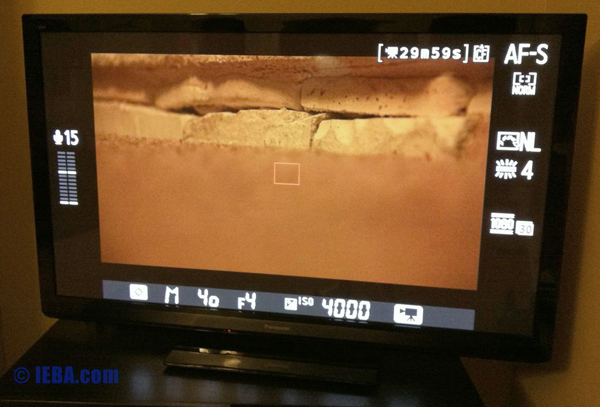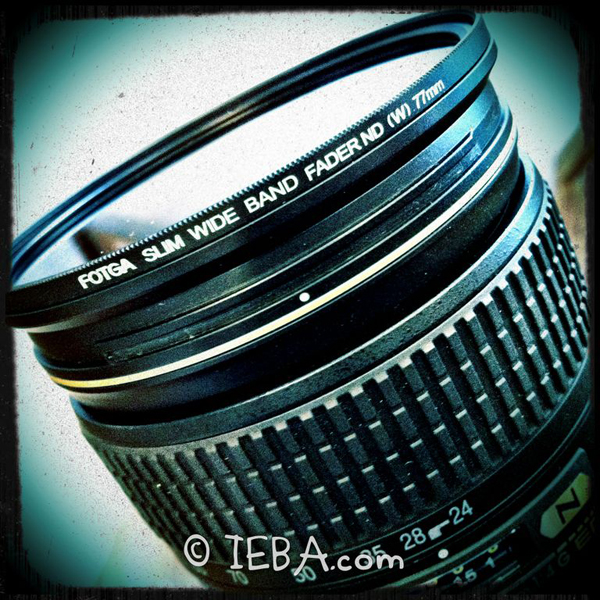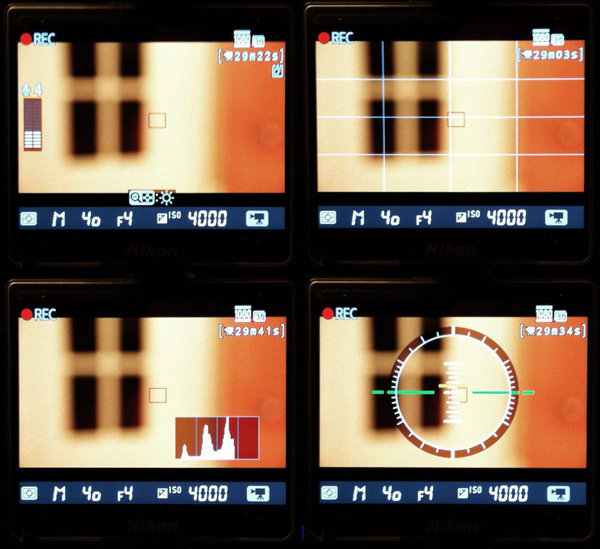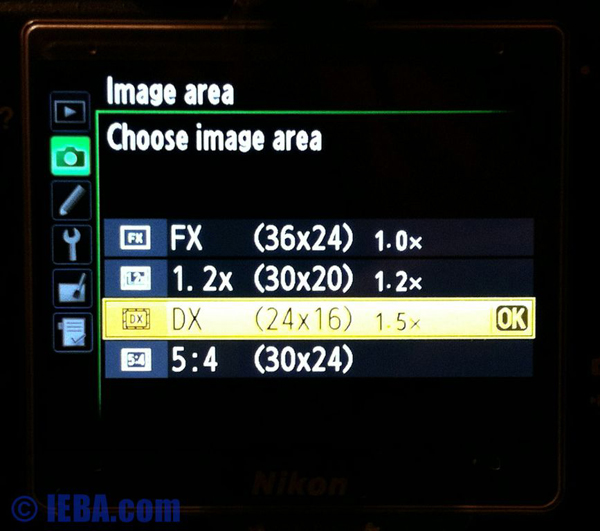Review: Nikon D800 DSLR Camera, Part 1
In this two-part series, we'll examine how well Nikon's much-heralded D800 DSLR works as a video camera, in terms of operability and functionality. In part two, we'll report on some audio and video tests comparing the D800 to another highly regarded DSLR, and to a more traditional prosumer camcorder.
HDMI Output
One of the signature features of the D800 is its "clean," uncompressed HDMI out. Initially, the HDMI out is windowed while recording (Figure 4, below). By this, I mean you see everything present on the square display on the back of the camera--readouts, settings, blank areas.

Figure 4. Windowed output on the HDMI out while recording
By going into the Setup > HDMI > Advanced > Live View on-screen display > and setting it to OFF, you can get an unadulterated feed out of the camera. It can output 1080i until you hit the Record button. Then it steps down to 720p.
Nikon D800 Exposure
There are typically three settings that shooters adjust to vary the exposure of an image: shutter, f-stop/aperture, and ISO/film speed. For most DSLR work, manual mode is preferable because you don't want the camera ramping up the shutter or aperture to where you don't want it. However, adjusting those settings in manual mode makes the image get brighter and darker with clearly obvious steps. So you'll never adjust your exposure with the manual camera settings while recording.
Using an auto mode, however, produces very smooth and natural adjustments when panning from bright sky to dark, covered areas. Just beware that the camera lacks the intelligence of today's camcorders to expose for faces and will underexpose a shot if the backlight, like a window, is bright, or overexpose the shot if the rest of the frame is very dark. It also ratchets up the shutter speed when things are bright, making your video very sharp, with no natural motion blur.
For convenience, professional DSLRs like the D800 have two adjustment wheels. These control iris and shutter. What they don't control is ISO. When you're recording something with a specific shallow depth of field (DoF)--say, f/2.0--at 24fps, which necessitates an appropriate manual shutter of 50fps, you'd like to be able to easily roll the ISO up or down a few stops to adjust exposure. But there's no way to assign that feature directly to one of the adjustment wheels.
Vari-ND
One great solution to this dillemma is using a neutral density (ND) filter in front of the lens. This enables you to set your ISO, shutter, and aperture to what you want, and then separately adjust the amount of light coming in to the lens, enabling you to keep the shutter and f-stop low, for that filmic look.
Now, in filmmaking, there's plenty of time to try 2, 3, or 4 different ND filters to find the one that gives you the exact exposure you want. But now there are variable ND filters that come in all sizes (and qualities) that you can mount to your lens and leave there. These are built by stacking two different polarizers on top of each other. When you rotate one polarizer against the other, they gradually block more light until they become nearly completely opaque.
Using a Vari-ND (Figure 5, below) makes getting the right exposure a piece of cake and solves the exposure dilemma. You can even use it in a run-n-gun situation by seting the vari-ND in the middle, adjusting your camera for a good exposure, and then merely adjusting the vari-ND to lighten or darken the shot as needed- even while recording. It doesn't give you as much capability as if you could dial in the entire ISO range of the camera, but when you need to subtly adjust the image brightness while shooting, it is a great solution.

Figure 5. An inexpensive 77mm Vari-ND filter on the Nikon Lens.
Live View Screens
If you tap the Info button on the D800, you can cycle through several types of live view screens, including one with a histogram (Figure 6, below). This histogram is critical for making sure your exposure is right. You simply cannot rely on the image on the screen because the brightness of the screen can be adjusted and there's no accurate calibration of the screen. Moreover, the screen is reflective--more so when it has the protective plastic cover on it. Anything that has available light hitting it is reflected on the screen. Using the screen outside is quite nearly an exercise in futility. It's just too reflective to rely on for exposure, or even framing your shot, unless you have a hood, loupe, or some other way to block external light. Once you block the light, the histogram can guide you to keeping the exposure good in any situation.

Figure 6. Can I get Audio Meters and Histogram on the same screen, please?
I just wish there was a way to get the audio meters and histogram on the same screen. On the D800, they're two info screens away from each other. For me, during testing, that meant I had to do a lot of button pushing to see what I needed to see while shooting.
DX Crop Mode
The D800 shoots full-frame video. So a 24-120mm lens is exactly what it says, unlike on smaller DSLRs that have an inherent crop factor. However, if you want to use a DX lens, made for a smaller sensor, the camera can crop the sensor for the smaller circle of light cast by the DX lens (Figure 7, below).

Figure 7. Three frame sizes, not much difference.
The beauty of an on-sensor crop is that you can even engage the 1.5x crop on the full-frame sensor regardless of what lens you are using. This enables my 120mm telephoto lens to operate like a 180mm lens and still record 1920x1080 video. It just uses less of the sensor. This can be handy if you have the camera all rigged up, and enabling an in-camera crop on a prime lens will get you the exact shot you need, if you didn't have that specific-length prime lens, and were unable to get the camera into the exact position you needed for the shot. Remember, you're not shooting 4k, and you're not shooting film, so any zooming in on the image in post is stretching the image and loses resolution.
When you consider that the D800 is starting with 7360x4912-pixel total resolution, I think an in-camera crop is one of the easiest ways for camera manufacturers to offer considerable additional value to a camera with just a little bit of additional programming. They can offer multiple crops of that sensor and still have gobs of resolution to provide an oversampled image for HD video recording. A 50mm lens could effectively be treated as a 50, 80, 120, 180, or 200 just by dialing in the amont of crop you want. Plus, you then can save considerable money by not having to buy so many high-quality prime lenses.
Currently, however, the crop in the D800 is made solely for photography needs--to enable DX lenses to be easily used on this full-frame camera. Here's looking forward to a time when the possibilities beyond the needs of still photography are imagined, and implemented.
Wrap-Up
So what we have is a very capable camera with some new audio capabilities added, minus a few caveats. It has many useful features, but they are hampered by how they are implemented in the camera, which is designed first and foremost for stills, not video. Not being able to see both the histogram and the audio meters on the same screen is a case in point.
There are also technologies, like on-sensor image crop, that could be extended to offer much greater operational convenience for shooting video, but are here limited to a specific photographic purpose.
In part 2, I'll delve deeper into the quality of the video and the audio that the D800 records, as well as testing the lens I have for more run-n-gun video needs.
Related Articles
D7100 features 24.1 megapixel CMOS sensor, 51 focus points including 15 cross-type sensors, 100-6400 ISO range, and new WU-1a wireless mobile adapter
In the P7700, Nikon has improved on earlier P7000 models with numerous video formats and a microphone input, plus a tilt-swivel display and several under-the-hood improvements. Is this the video-and-stills powerhouse I've been waiting for?
In Part 1 of this two-part series on the Nikon D800, I looked at the operation and functionality of the D800 DSLR as a video camera. Now, in Part 2, I'll share some usability notes, as report the results of some audio and video tests (with test footage) comparing the D800 to another highly regarded DSLR, the Panasonic GH2--to see if a lower-priced but very capable DSLR can measure up with quality glass--and to a more traditional prosumer camcorder.